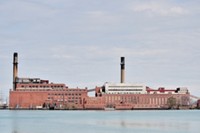Advertisement
Grab your lab coat. Let's get started
Welcome!
Welcome!
Create an account below to get 6 C&EN articles per month, receive newsletters and more - all free.
It seems this is your first time logging in online. Please enter the following information to continue.
As an ACS member you automatically get access to this site. All we need is few more details to create your reading experience.
Not you? Sign in with a different account.
Not you? Sign in with a different account.
ERROR 1
ERROR 1
ERROR 2
ERROR 2
ERROR 2
ERROR 2
ERROR 2
Password and Confirm password must match.
If you have an ACS member number, please enter it here so we can link this account to your membership. (optional)
ERROR 2
ACS values your privacy. By submitting your information, you are gaining access to C&EN and subscribing to our weekly newsletter. We use the information you provide to make your reading experience better, and we will never sell your data to third party members.
Environment
Soils Damaged By Acid Rain Begin Comeback
Air Pollution: Cuts to sulfur dioxide and nitrogen oxides have helped to restore calcium-depleted soils
by Janet Pelley
November 6, 2015

It’s been a quarter century since government regulations limiting emissions of sulfur and nitrogen oxides from coal-fired power plants began to neutralize the problem of acid rain, but lakes in the northeastern U.S. and eastern Canada have been sluggish to recover. Scientists have linked the delayed comeback to a lack of acid-buffering calcium in surrounding soils, which continued to acidify despite cuts in pollutants. Now, however, a study shows for the first time that soil acidification has begun to reverse across a broad swath from western Ontario to Maine (Environ. Sci. Technol. 2015, DOI:10.1021/acs.est.5b02904). Researchers hope improvements to forest health and lake water quality will follow.
Acid rain arises when sulfur dioxide and nitrogen oxides (NOx), emitted by burning fossil fuels, react with water droplets in the air to form sulfuric and nitric acid. Initially, ecosystems withstand acidic rain and snow because natural buffering agents in the soil, such as calcium, neutralize the acid. But over time, acid rain depletes calcium, and the acids start to accumulate, driving down the pH. “That’s when you mobilize dissolved inorganic aluminum,” says Gregory B. Lawrence, a biogeochemist with the U.S. Geological Survey. Soils have harmless forms of aluminum bound to organic matter and minerals, but the acid unleashes the metal in its highly toxic, dissolved form, where it flows into lakes and kills the fish and plankton.

A series of U.S. and Canadian regulations since the 1990s dramatically cut rates of acidic deposition, leading to steep declines in sulfuric acid in lakes. However, pH and aluminum levels were curiously slow to improve in response. A growing body of evidence tracked the cause of the delayed recovery of lakes to the continued lack of calcium in nearby soils, what some call “ecosystem osteoporosis”. Researchers found that soils continued to acidify despite cuts in acid rain. But those studies relied on data that only extended up to 2004. Lawrence suspected that with the passage of time, a new, more comprehensive study might yield different results.
To get a handle on long-term trends, he and his team put out a call to colleagues in the Northeastern Soil Monitoring Cooperative, who had sampled soils from eight to 24 years ago. These individuals returned to their old sites to collect fresh soil samples in forests from coastal Maine to the Adirondack Mountains, and from near Quebec City to western Ontario. The 27 sites comprised a variety of forest types and soil groups. Scientists took samples from the top organic layer of soil and the underlying mineral layer. Once back in the lab, the researchers used the same methods from their original studies to repeat tests for calcium, pH, and aluminum in the soil. Crucially, this approach allowed them to compare their new findings with those from years past.
Using a statistical test, the investigators determined whether the levels had changed or remained the same at each site. “I was surprised to see positive changes in several of the variables at most sites,” Lawrence says. The biggest difference came from aluminum in the top organic layer of soil, with concentrations declining at 14 locations by an average of 40%. pH values improved at a majority of sites in both the organic and mineral layers. None of the sites showed a decrease in calcium concentrations in the organic layer, and a few showed an increase. “These results suggest stabilization or possible reversal of soil calcium depletion,” he says. Calcium in the organic layer would come from the weathering of minerals in the underlying layer, so along with reductions in sulfuric acid deposition, perhaps enough time has passed to allow the calcium supply to replenish, he says.
“This is one of the first studies to show that soils are beginning to respond positively to declines in emissions of SO2 and NOx,” says Chris E. Johnson, an environmental geochemist at Syracuse University. The paper is significant because the data come from a large number of sites spread across a wide geographic range.





Join the conversation
Contact the reporter
Submit a Letter to the Editor for publication
Engage with us on Twitter